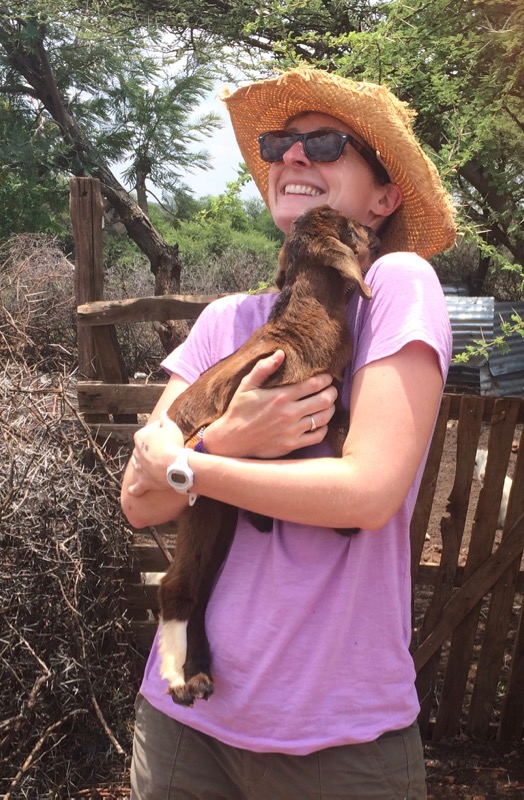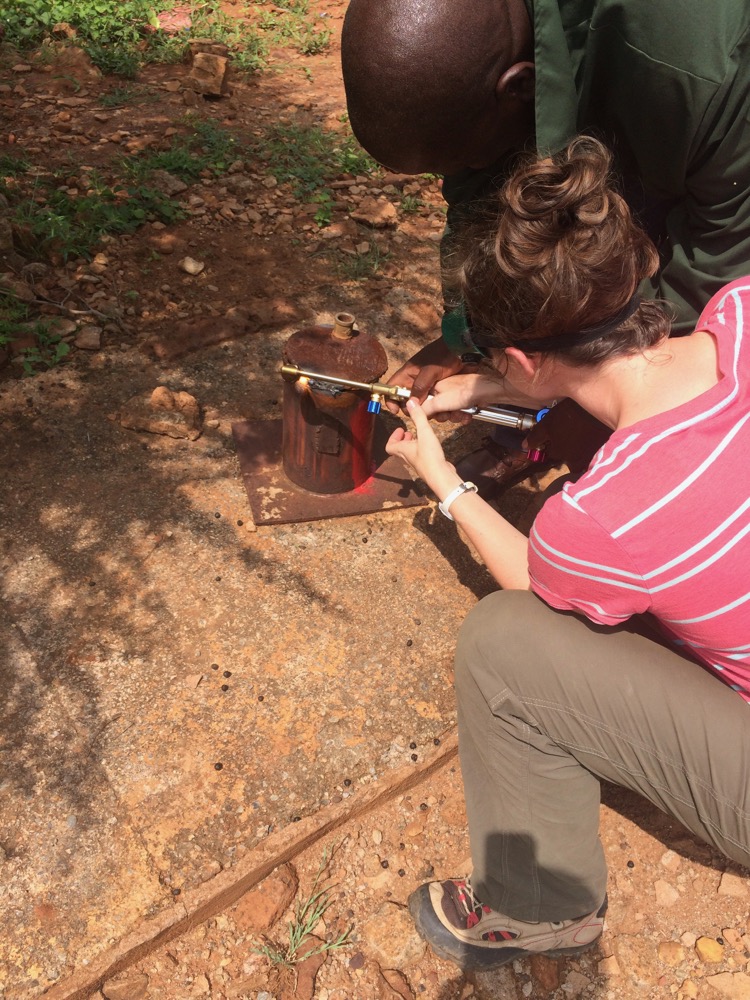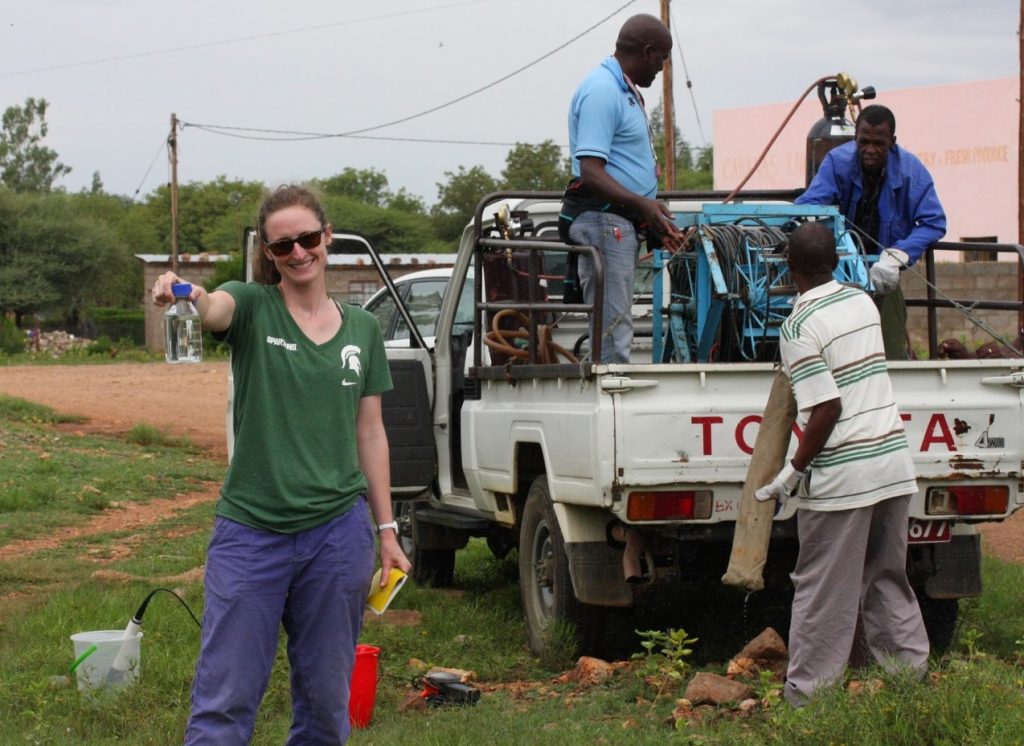
Sometimes you make new friends at the borehole sites, like this baby goat (pudi). (Photo courtesy of Bonnie McGill)
I’m Bonnie McGill, a KBS PhD student doing a USAID Borlaug fellowship in Botswana. The goal of my research is to determine the source of nitrate in a contaminated aquifer in Ramotswa, Botswana, and how the groundwater chemistry changes through the rainy season. I am based at the International Water Management Institute Southern Africa, which is based in Pretoria, South Africa.
Join me for a typical day of field work in Botswana.
I wake up at 6:30am in a hotel in Botswana’s capital, Gaborone (pronounced “HAB-uh-RO-nee” or just “Gabs”). The sun is already bright and hot, and it will get up to 40°C (104°F) today. I get a message from my field assistant who is sick today, and a second message saying that my collaborator can’t come today, but I roll out of bed anyway.
I grab a quick breakfast at the hotel restaurant where a sappy Nollywood show is on the TV. I say, “Ke a leboga ta ta, bo-mma” to thank the cooks in Setswana and get in my little Toyota Avanza (a tiny minivan). It’s a manual transmission, and I sit on the right side of the car and drive on the left side of the road, watching out for unpredictable taxi van drivers, rampant running of red “robots” (traffic lights), and livestock and pedestrians in the road.
It takes about 40 minutes to reach the small village where I planned to meet the Botswana Geological Institute (BGI) crew who have a welder and pump for collecting samples. They call from Lobatse (further south) and ask if I have a generator, because theirs isn’t working. I can arrange to borrow one from the Department of Water Affairs, although it will take the BGI crew two hours to go get the pump in Gabs and come back.
My day is already off to a disappointingly slow start. I can only pump three or maybe four boreholes a day, so it takes five days just to collect 15 samples. However, I don’t get upset about today’s delays because I know this is how field work works.
While waiting for the crew to arrive, I watch a donkey cart go by carrying fire wood, the cloud of termite alates emerging, and the Brahman cattle and Boer goats roaming along the road side grazing on grass that seems to belong to no one and to everyone.
Finally the second truck arrives, about 10 men, and it’s after 1200h. The borehole is a hole in the ground, with a casing that is typically about 20 cm in diameter and 100-150 m deep though the water table is only 5-30 m belowground. Joseph, the welder, cuts the metal cap off the casing and Phemo starts unreeling the dip meter down the borehole to measure the depth to the water table.

Using an oxyacetylene torch to cut the cap off of a monitoring borehole with the help of Mr. Gaabadzo Mannathoko in Ramotswa. (Photo courtesy of Bonnie McGill)
Then Mpho backs the truck up so that the tailgate is almost directly over the borehole. They unwrap the precious beast of burden submersible pump and lower it to a depth of 20 meters. All the while chatting in Setswana, which they teach me along the way.
Richard fires up the generator to start pumping the water out and then everyone waits about 45 minutes while I record water quality measurements with the sensor I brought from KBS (thank you, Steve!). When the numbers have stabilized I collect and filter my samples.
The generator is very loud, so I motion to the crew that we’re done and they can turn off the generator. Then we re-measure the depth to water table, reel in the pump by hand, and weld the cap back on the borehole. By this time, it is almost 1400h (2pm) and the crew wants to get back to Lobatse early for a union meeting.
BGI is covering their pay and the petrol, so, if the pump crew is finishing at 1400h, I’m finishing at 1400h. I drive another hour to northern Gabs to the Water Utilities Corporation (the para-statal water utility) lab, where they will analyze that day’s one hard-fought sample for fecal coliforms. The rest go back to Pretoria with me at the end of the week.
I stop by Nando’s on the way back to the hotel to get dinner to go. The cashier remembers me because I am maybe the only white person that has come in that day and quite possibly the only person to ever order a veggie burger there, which I did yesterday and the day before.
Back at the hotel I move the remaining samples from the cooler to a plastic bag inside the mini-fridge in my room. Then, I get the equipment ready for the next day all the while listening to a South African news report about how many in the ANC (the African National Congress, Mandela’s political party) are trying to get rid of Jacob “I took a shower” Zuma (Google it). Finally I scrub my hands like I’m about to perform brain surgery, and eat my delicious veggie burger and side of collards.
I fall asleep trying to remember how to say good night in Setswana…
“Boroko.”

After pumping a monitoring borehole in Ramotswa with the Botswana Geological Institute crew (from left, me, Mr. Victor Mathumo, Mr. Simon Thumpe, and Mr. Aupa Kgobe). (Photo courtesy of Bonnie McGill)
Bonnie McGill is a graduate student in the Hamilton Lab at KBS in MSU’s Department of Integrative Biology.

A legacy of conservation; a commitment to sustainability.
3700 E. Gull Lake Drive
Hickory Corners, MI 49060
(269) 671-5117
info@kbs.msu.edu